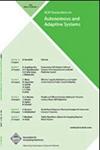利用遗传规划构建软件定义网络的自适应
IF 2.2
4区 计算机科学
Q3 COMPUTER SCIENCE, ARTIFICIAL INTELLIGENCE
引用次数: 0
摘要
自适应解决方案需要定期监控、推理和调整运行中的系统。自适应步骤包括生成自适应策略,并在出现异常时将其应用于运行系统。在这篇文章中,我们认为,与其生成单独的适应策略,不如调整运行系统的控制逻辑,使系统本身学会如何避开未来的异常,而不会过于频繁地触发自适应。尽管适应的需求从未被消除,特别是注意到复杂系统的不确定和不断发展的环境,但由于各种原因,减少适应干预的频率是有利的,例如,提高性能和使运行系统更加稳健。我们实例化并实证研究了软件定义网络的上述思想,这是现代数据中心和物联网应用的关键技术。使用遗传规划(GP),我们提出了一种自适应解决方案,该解决方案可以不断学习和更新软件定义网络的数据转发逻辑中的控制结构。我们使用开源合成和工业数据进行的评估表明,与试图产生个体适应的基线适应技术相比,我们基于GP的方法在解决网络拥塞方面更有效,并随着时间的推移进一步降低了适应干预的频率。此外,我们还表明,对于具有相同拓扑的网络,在较大网络上重用在较小网络上学习的知识,可以显著提高我们基于GP的自适应方法的性能。最后,我们将我们的方法与网络文献中的标准数据转发算法进行了比较,表明我们的方法显著减少了数据包丢失。本文章由计算机程序翻译,如有差异,请以英文原文为准。
Using Genetic Programming to Build Self-Adaptivity into Software-Defined Networks
Self-adaptation solutions need to periodically monitor, reason about, and adapt a running system. The adaptation step involves generating an adaptation strategy and applying it to the running system whenever an anomaly arises. In this article, we argue that, rather than generating individual adaptation strategies, the goal should be to adapt the control logic of the running system in such a way that the system itself would learn how to steer clear of future anomalies, without triggering self-adaptation too frequently. While the need for adaptation is never eliminated, especially noting the uncertain and evolving environment of complex systems, reducing the frequency of adaptation interventions is advantageous for various reasons, e.g., to increase performance and to make a running system more robust. We instantiate and empirically examine the above idea for software-defined networking – a key enabling technology for modern data centres and Internet of Things applications. Using genetic programming (GP), we propose a self-adaptation solution that continuously learns and updates the control constructs in the data-forwarding logic of a software-defined network. Our evaluation, performed using open-source synthetic and industrial data, indicates that, compared to a baseline adaptation technique that attempts to generate individual adaptations, our GP-based approach is more effective in resolving network congestion, and further, reduces the frequency of adaptation interventions over time. In addition, we show that, for networks with the same topology, reusing over larger networks the knowledge that is learned on smaller networks leads to significant improvements in the performance of our GP-based adaptation approach. Finally, we compare our approach against a standard data-forwarding algorithm from the network literature, demonstrating that our approach significantly reduces packet loss.
求助全文
通过发布文献求助,成功后即可免费获取论文全文。
去求助
来源期刊

ACM Transactions on Autonomous and Adaptive Systems
工程技术-计算机:理论方法
CiteScore
4.80
自引率
7.40%
发文量
9
审稿时长
>12 weeks
期刊介绍:
TAAS addresses research on autonomous and adaptive systems being undertaken by an increasingly interdisciplinary research community -- and provides a common platform under which this work can be published and disseminated. TAAS encourages contributions aimed at supporting the understanding, development, and control of such systems and of their behaviors.
TAAS addresses research on autonomous and adaptive systems being undertaken by an increasingly interdisciplinary research community - and provides a common platform under which this work can be published and disseminated. TAAS encourages contributions aimed at supporting the understanding, development, and control of such systems and of their behaviors. Contributions are expected to be based on sound and innovative theoretical models, algorithms, engineering and programming techniques, infrastructures and systems, or technological and application experiences.
 求助内容:
求助内容: 应助结果提醒方式:
应助结果提醒方式:


